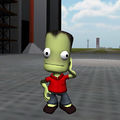Kerbal
From Kerbal Space Program Wiki

Kerbal astronaut in EVA
Kerbals are the native denizens of the planet Kerbin. Kerbals appear to be bipedal. Mature kerbals stand roughly 0.75 meters in height, and weigh approximately 90 kilograms.
Kerbals have a massive head with respect to their bodies, being nearly 50% of an adult kerbal's body mass.
Biology

Kerbal from Kerbalizer
- Although Kerbals appear mostly hairless, they have notable hair growth occurring chiefly on the top of the head.
- Kerbal skin hues appear to range from light green to pale green.
- Kerbals are capable of spending years in space without showing any signs of muscle atrophy or other ill effects.
- Kerbals can survive for years with minimal or no food and oxygen supply.
- One theory is that they are able to enter a state of hibernation to endure long space travels.
- Another theory is that their green skin may contain chlorophyll allowing them to photosynthesize their own food.
- They may also not need oxygen to breathe, as they have no nose and can survive with their mouth closed.
- Kerbals are prone to dying from shock when exposed to unexpected technological innovations. Anecdotal evidence for this can be found in the descriptions of the Rockomax Hubmax Multi-Point Connector and the RoveMax Model 3. For some reason this doesn't seem to apply to innovative rocket concepts. These usually kill them in other ways.
- All Kerbals seem to be male (at least the ones approved to go into space), judging by their names. They might also be genderless.
- As far as can be seen via artwork and ingame modeling, Kerbals appear to have two, large teeth that span the length of their gums. One on the mandible, and one on the skull.
- Kerbal corneas protrude from the eyeball significantly, as do their eyes from the skull. In addition, they also possess no eyelids, making their eyes a vulnerable spot for injuries.
- Kerbals have an awkward, sprawling walk due to their wide pelvis and short legs, indicating that their species may not have evolved to walk originally, and that it is something they learned recently.
Language
- Kerbals can speak, as of some recent trailers. Currently they do not speak in-game.
- They do emit sounds like "aha" in-game, during the tutorials.
- In trailers they speak reverse Spanish.
Material culture and technology
- Limited observation makes this difficult to determine. Kerbal technology and architecture appears to share many similarities with the modernized nations of Earth during the 1970-2000's, however no city landscapes currently exist (0.20).
- One theory on the scarcity of buildings on Kerbin could be related to the lack of wildlife and trees on the planet. Kerbal civilisation may live underground due to some unknown factor.
- Due to the humorous descriptions of parts in-game, it can be assumed Kerbals are, to some extent, less intelligent than Human Beings.
- Kerbals usually find planets by accident, usually involving what was thought by its discoverer to be a piece of dust or a smudge on the lens.
- Kerbals seem to be in infinite supply, perhaps everyone wants to be a kerbonaut, or the planet Kerbin itself spews out the little green men.
- It appears that the Kerbals' culture revolves singly around the process of designing, building, launching, and riding rockets and planes. Every Kerbal made structure on Kerbin is devoted to these four tasks.
Gallery
See also
- Jebediah Kerman the first Kerbonaut


